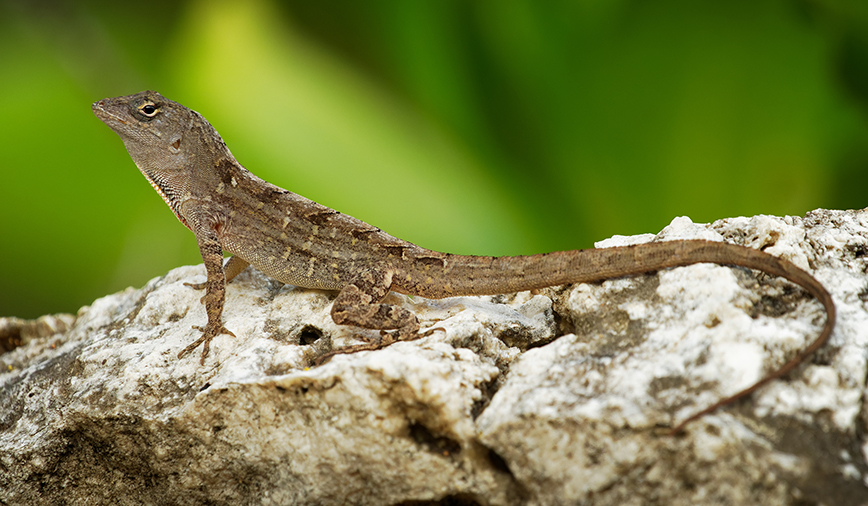Measuring a little over two inches in length, this hatchling brown anole was the surprise bonus in a local resident’s houseplant purchase. Native to the Caribbean, brown anoles have been introduced throughout Florida and now are making their way to other states as well.
October 17, 2014
Anole
Don’t you just love life’s little surprises?
You reach in your coat pocket and find a forgotten $5 bill. Yay!
You run into an old friend at the grocery store. Yippee!
You water your houseplant, and a lizard pops out of the soil.
Say wha…?
Surprising as it sounds, that’s exactly what happened to a local resident the other day as she tended a plant she’d bought online a few weeks back. I don’t know what type of plant it was, nor from which web site it was purchased. But I’ll bet my mother-in-law’s tongue (Sansevieria spp.) that the plant was produced by a grower in Florida.
How do we know this? Because the surprise lizard is a brown anole, Anolis sagrei, a small, nonnative species that was introduced to south Florida from the Caribbean in the late 1880s. Finding the Sunshine State to its liking, little A. sagrei steadily advanced northward and today can be found in nearly every region in Florida, as well as assorted locales in Georgia, Louisiana and Texas.
Such expansion is quite an accomplishment for a reptile that, fully grown, measures just over 8 inches in length. But the brown anole has several factors working in its favor. Its generalist diet includes a wide variety of insects, spiders and other invertebrates—all of which are in abundant, year-round supply. It thrives in disturbed landscapes—another feature which Florida has in abundance.
Perhaps most important, this species gets moved around a lot by people. Some of this movement is intentional, as folks often keep brown anoles as pets. But much is accidental, with the lizards getting transported as stowaways in boats and firewood.
And houseplants.
Thanks to a reproductive strategy that includes laying eggs one or two at a time, in soft, moist soil, brown anoles have found ideal habitat among the many greenhouses and outdoor growing plots that dot the Florida landscape.
Lay an egg, move along. A week or so later, lay another egg and move along. All summer long.
Female brown anoles are capable of laying 15 to 18 eggs per breeding season. That number doesn’t seem like a lot, until you consider the advantage of this one-at-a-time approach. It’s almost as if the brown anole heard the adage, “Don’t put all your eggs in one basket,” and decided, then and there, “Alrighty then, I won’t!”
Just as wise investors diversify their portfolios, lest one company should fail, brown anoles spread their offspring around. Sure, one egg here or there may be predated, infected or crushed, but chances are good that at least some of the offspring will survive.
Compare this strategy to certain other lizard species that deposit all their eggs in a single clutch. One visit by a predator, one big rush of floodwater, and it’s bye-bye next generation.
Adding to the brown anole’s many range-expanding advantages is the fact that they’re just darn cute.
Related to the Carolina anole—the lizard that changes color from green to brown, and used to be labeled “Chameleon” in pet stores across the country—the brown anole has a blunter nose and, often, irregular patterns of spots, chevrons and light-colored lines. An intense gaze and lively habits only add to its endearing qualities.
As you’ve probably guessed by now, we decided to adopt the little houseplant-borne anole. Although we’re pretty limited on space and enclosures for live animals, we thought this animal would have potential as part of an interpretive display on nonnative species. Plus, did I mention, the little guy is just darn cute?
Cute, but tiny. When the lizard, clearly a hatchling, arrived at Hickory Knolls it was only about the length of a toothpick–and almost as thin. Regular misting and a steady diet of fruit flies have had a positive effect though and, today, “Baby” is nearly twice as big as when s/he arrived. A few more milligrams of weight and millimeters of length and the Little Lizard That Could will be ready to educate visitors of all ages about the issues associated with wildlife species that are introduced to areas beyond their native range.
If you’re planning a trip to Hickory Knolls sometime soon, keep an eye out for this newest addition. You may think you’re peering into an enclosure filled with filled with random sticks and leaves. But look a little closer at those small branches…
Surprise! Like the woman who watered her newly purchased houseplant, you may find Baby staring right back at you.
Pam Erickson Otto is the manager of nature programs and interpretive services at the Hickory Knolls Discovery Center, a facility of the St. Charles Park District. She can be reached at 630-513-4346 or potto@stcparks.org.

